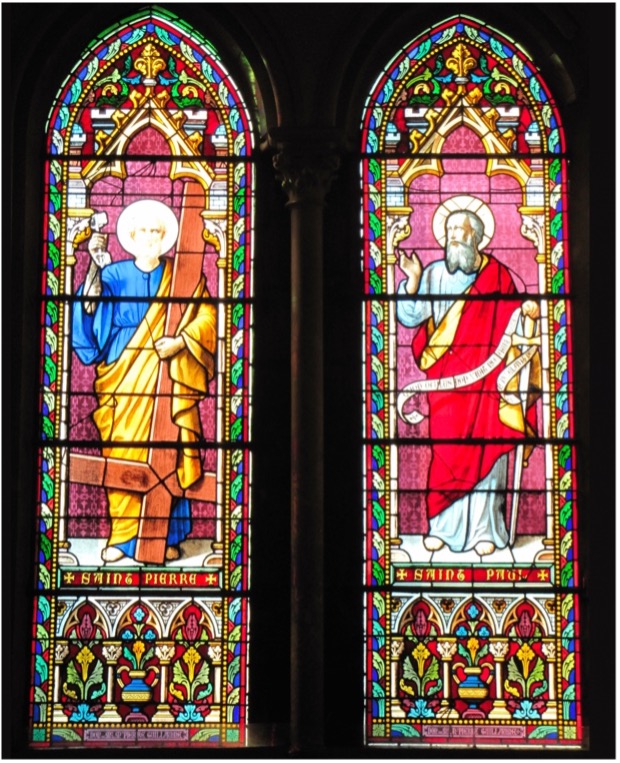Bulletin Insert: The Feast of St. Peter and St. Paul – June 26, 2022
On June 29th, the Church will remember the martyrdoms of Sts. Peter and Paul, apostles and martyrs.
While there are no explicit testaments to the deaths of St. Peter or St. Paul in Scripture, and though they were not martyred at the same time, tradition has placed the commemoration of their deaths together, as a result of the Neronian persecution of Christians in 64 A.D. Placing the commemoration on June 29th was likely a reference to an event in 258 A.D. when the remains of the martyrs were moved from their resting places to avoid desecration during persecutions ordered by Valerian.
According to Holy Women, Holy Men, the martyrdoms of these apostles were markedly different. The book records, “As a Roman citizen, Paul would probably have been beheaded with a sword” (HWHM, 446). His death would have been faster and less painful than that of Peter, who, tradition holds, was crucified upside-down at his own request, considering himself unworthy of dying the same way as Jesus.

Images of Sts. Peter and Paul often include the instruments of their martyrdoms. Paul may be depicted holding a sword and holding open a book that reads “Spiritus Gladius,” or “sword of the Spirit.” This references both Paul’s beheading with a sword and his letter to the Ephesians, in which he asks the Church to take up “the sword of the Spirit, which is the word of God” (Eph. 6:17). Peter, along with his traditional symbols of keys to the kingdom of heaven, is regularly depicted with an inverted cross.
The relationship between the two can be instructive to us as modern-day Christians. From Holy Women, Holy Men, “Paul, the well-educated and cosmopolitan Jew of the Dispersion, and Peter, the uneducated fisherman from Galilee, had differences of opinion in the early years of the Church concerning the mission to the Gentiles. More than once, Paul speaks of rebuking Peter for his continued insistence on Jewish exclusiveness; yet their common commitment to Christ and the proclamation of the Gospel proved stronger than their differences; and both eventually carried that mission to Rome” (HWHM, 446). Where might we within the Church learn to appreciate each other’s differing viewpoints? How can our common commitment to Jesus Christ and the Gospel carry us to the testing ground and beyond?
Collect for St. Peter and St. Paul
Almighty God, whose blessed apostles Peter and Paul glorified you by their martyrdom: Grant that your Church, instructed by their teaching and example, and knit together in unity by your Spirit, may ever stand firm upon the one foundation, which is Jesus Christ our Lord; who lives and reigns with you, in the unity of the Holy Spirit, one God, for ever and ever.
26 de junio de 2022 – Pentecostés 3 (C)
La fiesta de San Pedro y San Pablo
El 29 de junio, la Iglesia recordará los martirios de los santos Pedro y Pablo, apóstoles y mártires.
Aunque no haya testimonios explícitos de las muertes de San Pedro o San Pablo en las Escrituras, y aunque no fueron martirizados juntos, la tradición ha colocado juntamente la conmemoración de sus muertes, como resultado de la persecución neroniana de los cristianos en 64 d C. La conmemoración del 29 de junio fue probablemente una referencia a un día alrededor del año 258, cuando los restos de los mártires fueron trasladados de sus lugares de descanso para evitar la profanación durante las persecuciones ordenadas por Valerio.

Según Santas, Santos, los martirios de estos apóstoles fueron marcadamente diferentes. El libro escribe: “Como ciudadano romano, Pablo probablemente habría sido decapitado con una espada” (HWHM, 446). Su muerte habría sido más rápida y menos dolorosa que la de Pedro, que, según la tradición, fue crucificado al revés por propia petición, considerando que era indigno de morir de la misma manera que Jesús.
Imágenes de los santos Pedro y Pablo a menudo incluyen los instrumentos de sus martirios. Pablo puede ser representado sosteniendo una espada y sosteniendo un libro que dice “Spiritus Gladius”, o “espada del Espíritu”. Esto hace referencia a la decapitación de Pablo con una espada y a su carta a los efesios, en la que pide a la iglesia que tome “La espada del Espíritu, que es la palabra de Dios” (Efesios 6:17). Pedro, junto con sus símbolos tradicionales de las llaves del reino de los cielos, se representa regularmente con una cruz invertida.
La relación entre los dos puede ser instructiva para nosotros como cristianos modernos. Del libro Santas, Santos, “Pablo, el judío bien educado y cosmopolita de la Dispersión, y Pedro, el pescador sin educación de Galilea, tuvieron diferencias de opinión en los primeros años de la Iglesia con respecto a la misión a los gentiles. Más de una vez, Pablo habla de reprender a Pedro por su continua insistencia en la exclusividad judía; sin embargo, su compromiso común con Cristo y la proclamación del Evangelio resultaron más fuertes que sus diferencias; y ambos llevaron finalmente esa misión a Roma” (HWHM, 446). ¿Dónde podríamos dentro de la Iglesia aprender a apreciar los diferentes puntos de vista de cada uno? ¿Cómo puede nuestro compromiso común con Jesucristo y el Evangelio llevarnos a la prueba y más allá?
Oración para San Pedro y San Pablo
Dios todopoderoso, cuyos benditos apóstoles Pedro y Pablo te glorificaron con su martirio: Concede que tu Iglesia, instruida por su enseñanza y ejemplo, y unida en unidad por tu Espíritu, pueda permanecer firme sobre el único fundamento, que es Jesucristo nuestro Señor; que vive y reina contigo, en la unidad del Espíritu Santo, un solo Dios, por los siglos de los siglos.
Don’t forget to subscribe to the Sermons That Work podcast to hear this sermon and more on your favorite podcasting app! Recordings are released the Thursday before each liturgical date.
Receive Free Weekly Sermons That Work Resources!


